Landmine Monitor 2018
Support for Mine Action
Article 6 of the Mine Ban Treaty on international cooperation and assistance recognizes the right of each State Party to seek and receive assistance from other States Parties in order to fulfill its treaty obligations. This chapter focuses on financial support for mine action provided for calendar year 2017 by affected countries and international donors. It also documents new funding announcements made by some donors in 2018 to support mine action efforts. Cooperation and assistance, however, is not only limited to financial assistance. Other forms of assistance can include the provision of equipment, expertise, and personnel, as well as the exchange of experience, know-how, and best-practice sharing.
2017 Figures and Trends
Total Support to Mine Action—Thirty-seven donors and 10 affected states reported contributing US$771.5 million in international and national support for mine action in 2017[1]; this is $203.6 million more than the revised 2016 amount (a 36% increase). Taking into consideration inflation, it represents the second highest annual total of international and national mine action funding since the Monitor began reporting.[2]
International contributions accounted for 87% of overall support for mine action in 2017, while states’ contributions to their own national mine action programs accounted for the remaining 13% of global funding.
International Contributions—The level of international support for mine action provided by donors increased for the second consecutive year, rising from $482.9 million in 2016 to $673.2 million in 2017 (a 39% increase). This represents the highest level of international support recorded by the Monitor.[3]The 2017 rise was primarily driven by massive increases in the contributions of the United States (US) and Germany.
- The majority of the funding came from just a few donors, with the top five donors—the US, Germany, the European Union (EU), Norway, and Japan—contributing a total of $532.7 million, or 79% of all international funding for 2017.
- The top five recipient states—Iraq, Syria, Colombia, Afghanistan, and Lao PDR—received a combined total of nearly $435.4 million, representing 65% of all international contributions.
- International funding was distributed among the following sectors: clearance and risk education (59% of all funding), victim assistance (2%), capacity-building (1%), and advocacy (1%). The remaining 37% was not disaggregated by the donors.
National Contributions—The Monitor identified 10 affected states that provided $98.3 million in contributions to their own national mine action programs, $13.3 million more than in 2016 (a 16% increase), when 11 affected countries reported contributing $85.0 million.
International Contributions in 2017
For the second year running, donors increased their international mine action assistance in 2017 and provided $673.2 million in funding to 38 affected states and three other areas. This represents an increase of more than $190 million (39%) from the $482.9 million reported in 2016, and almost twice as much as the $376.5 million reported in 2015.[4]
International support for mine action: 2007–2017*
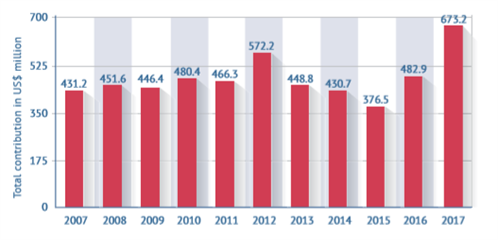
Note: * Not adjusted for inflation.
The 2017 rise is in large part due to the substantial increases in the contributions of the US and Germany:
- US funding in 2017 ($309.0 million) doubled from 2016. More than half of the US contribution ($169.6 million) went to mine action projects in Iraq and Syria.[5] In comparison, this is $17 million more than its 2016 total contribution of $152.4 million. The US provided $106.6 million to activities in Iraq aimed at clearing Islamic State explosive remnants of war (ERW) in order to facilitate the restoration of critical infrastructure and services, as well as the safe return of displaced populations. This represents a tripling in its contribution to this country compared to the $30.9 million provided in 2016. In addition, the US contributed $63 million to support clearance in areas liberated from Islamic State in northeast Syria, as well as risk education activities. This is six-times higher than US funding provided to this country in 2016.
- Germany’s funding in 2017 ($84.4 million) more than doubled from 2016. Germany’s largest contribution went to Iraq ($47.3 million) for clearance, victim assistance, and capacity-building activities. This represents more than half of its total contribution for the year, and more than double the funding provided to Iraq in 2016. Syria also received substantial funds from Germany, with $13.9 million provided.
Pledges in 2018
At the Maputo Review Conference, in June 2014, States Parties committed to complete their respective time-bound obligations by 2025. This commitment has led to a number of initiatives and announcements aimed at strengthening international cooperation and assistance, and promoting the need for predictable adequate funding in order to meet the goal of a mine-free world by 2025.[6]
In February 2018, 33 States Parties, one state not party, the EU, as well as non-governmental and international organizations attended the Third Pledging Conference for the Implementation of the Mine Ban Treaty, hosted by Afghanistan in Geneva. In total, 11 States Parties[7] made pledges to the treaty’s Implementation Support Unit (ISU) and sponsorship program. Four additional States Parties—Austria, Belgium, Canada, and Sweden—indicated their intention to support the work of the treaty but were not in a position to pledge a specific amount as their respective budgets were still under review.
In addition, some mine action donors renewed their commitment to providing financial resources:
- In March 2018, South Korea announced a pledge of $20 million to support clearance and capacity-building activities in the provinces of Quand Binh and Binh Dinh as part of the Korea-Vietnam Mine Action Project.[8]
- In June 2018, Australia announced new funding to mine action activities conducted by the United Nations Mine Action Service (UNMAS) in Iraq (A$11 million/US$8.2 million over 2019–2021) and Syria (A$8 million/US$6 million over 2018–2019).[9]
- In September 2018, the United Kingdom (UK) announced the provision of an additional £46 million (some $58 million) to support demining, risk education, and capacity development projects in Angola, Cambodia, Lao PDR, Lebanon, Myanmar, Somalia, South Sudan, and Vietnam.[10]
Donors in 2017
In 2017, 28 Mine Ban Treaty States Parties, two states not party, the EU, and six other institutions[11] contributed a total of $673.2 million to mine action.
A small group of donors continued to provide the majority of international mine action support with the five largest donors (the US, Germany, the EU, Norway, and Japan) accounting for nearly four-fifths of all international support with a combined total of $532.7 million. The US remained the largest mine action donor with $309 million and it alone provided nearly half of all international mine action support in 2017. Germany ranked second with $84.4 million, or 13% of all contributions, while the next three donors—the EU, Norway, and Japan—provided more than $30 million each.
Another 17 donors contributed less than $1 million each, compared to 11 contributing in that range in 2016.
Support from States Parties in 2017 accounted for two-fifths of all donor funding, with 28 countries providing some $269.2 million. This represents a 9% increase from the $246 million recorded in 2015.
In 2017, the EU and its member states[12] contributed a total of $233.1 million and accounted for 35% of the total international support, up from $194 million provided in 2016 (40% of the total international funding for that year).
Contributions by donors: 2013–2017[13]
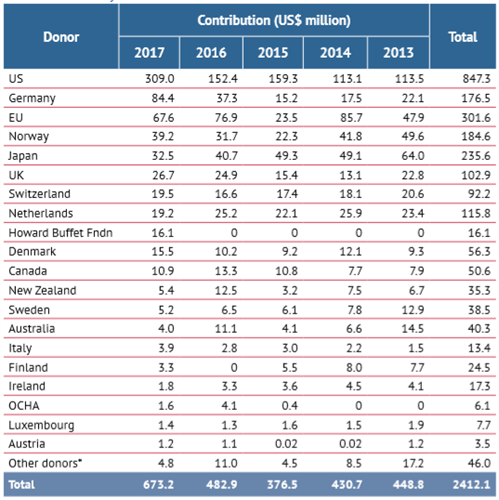
Note: * Other donors in 2017 included: Andorra, Belgium, Czech Republic, Estonia, France, Liechtenstein, Monaco, Poland, Portugal, Slovenia, South Korea, Spain, Turkey, the Organization for the Petroleum Exporting Countries (OPEC) Fund for International Development (OFID), Sudan Humanitarian Fund, United Nations Association (UNA)-Sweden, and the UN.
Fifteen donors contributed more in 2017 than they did in 2016; including a $157 million increase from the US (103%), and a $47 million increase from Germany (126%). Additionally, Norway increased its assistance by $7.5 million. Five new donors were also identified in 2017: Finland,[14] Monaco, Portugal, the Howard Buffett Foundation, and the UN.
In contrast, 17 donors decreased their funding, led by the EU (down $9.3 million, a 12% decrease) and Japan (down $8.3 million, a 20% decrease). Additionally, Australia, New Zealand, and the Netherlands decreased their assistance by more than $6 million each.
Summary of changes in 2017
|
Change |
Donors |
Combined Total |
|
Increase of more than $10 million |
Germany and the US |
$203.7 million increase |
|
Increase of less than $10 million |
Andorra, Austria, the Czech Republic Denmark, Italy, Luxembourg, Norway, Poland, Slovenia, Switzerland, the UK, OPEC OFID, and UNA-Sweden |
$19.4 million increase |
|
Decrease of more than $1 million |
Australia, Belgium, Canada, France, Ireland, Japan, the Netherlands, New Zealand, South Korea, Sweden, the EU, and OCHA |
$52.4 million decrease |
|
Decrease of less than $1 million |
Estonia, Spain, Turkey, and the Sudan Humanitarian Fund |
$0.8 million decrease |
|
New donors in 2017 |
Finland, Monaco, Portugal, the Howard Buffett Foundation, and the UN |
$20.4 million provided in 2017 |
The table below summarizes the changes in mine action funding from the top 15 donors, expressed in their respective national currencies and US$ terms.
Changes in mine action funding in national currency terms and US$ terms[15]
|
Donors |
Amount of decrease/increase (national currency) |
% change from 2016 |
Amount of decrease/increase (US$) |
% change from 2016 (US$) |
|
Germany |
+ €41.0 million |
+121% |
+ 47.1 million |
+126% |
|
US |
+ US$156.6 million |
+103% |
+ 156.6 million |
+103% |
|
Denmark |
+ DKK33.6 million |
+49% |
+5.3 million |
+52% |
|
Italy |
+ €0.9 million |
+37% |
+1.1 million |
+40% |
|
Norway |
+ NOK57.9 million |
+22% |
+7.5 million |
+24% |
|
Switzerland |
+ CHF2.9 million |
+18% |
+2.9 million |
+18% |
|
UK |
+ £2.4 million |
+13% |
+1.8 million |
+7% |
|
EU |
- €9.7 million |
-14% |
-9.3 million |
-12% |
|
Canada |
- C$3.4 million |
-19% |
-2.4 million |
-18% |
|
Japan |
- ¥787.8 million |
-18% |
-8.2 million |
-20% |
|
Sweden |
- SEK11.0 million |
-20% |
-1.3 million |
-20% |
|
Netherlands |
- €5.8 million |
-25% |
- 6.0 million |
-24% |
|
Ireland |
- €1.4 million |
-46% |
-1.5 million |
-45% |
|
New Zealand |
- NZ$10.3 million |
-58% |
-7.1 million |
-57% |
|
Australia |
- A$9.7 million |
-65% |
-7.1 million |
-64% |
Funding Paths
Donors contributed to mine action through several trust fund mechanisms, notably the UN Voluntary Trust Fund for Assistance in Mine Action (VTF) administered by UNMAS and ITF Enhancing Human Security (established by the government of Slovenia and formerly known as the International Trust Fund).
In 2017, contributions through UNMAS totaled $81.7 million from 24 donors. Several small donors used the VTF to contribute to mine action.[16] Six donors as well as the OPEC Fund for International Development (OFID) and the UN allocated $3.8 million in 2017 through the ITF for mine action programs in seven states and one area.
While donor funding frequently is used for national activities, implementation is often carried out by an array of partnering institutions, NGOs, trust funds, and UN agencies. Organizations that received a significant proportion of contributions in 2017 included Mines Advisory Group ($32.9 million), Norwegian People’s Aid ($23.2 million), HALO Trust ($20.5 million), the International Committee of the Red Cross (ICRC) ($11.3 million), DanChurchAid ($11.5 million), the Geneva International Centre for Humanitarian Demining ($11.3 million), and Humanity & Inclusion ($8.6 million).
Recipients
A total of 38 states and three other areas received $627.3 million from 37 donors in 2017. A further $46 million, designated as “global” in the table below, was provided to institutions, NGOs, trust funds, and UN agencies without a designated recipient state or area.
As in previous years, a small number of countries received the majority of funding. The top five recipient states—Iraq, Syria, Colombia, Afghanistan, and Lao PDR—received 65% of all international support in 2017.
Iraq received the largest amount of funding (30% of all international support) from the largest number of donors (17).[17] Eleven states and one area, or 29% of all recipients, had only one donor.[18]
More than three-fifths of international support (63%, or $423.2 million) went to 16 countries or one other area with massive contamination ($320.2 million) and heavy contamination ($103.0 million).[19] Most of this funding went to clearance and risk education projects.
List of international support recipients in 2017
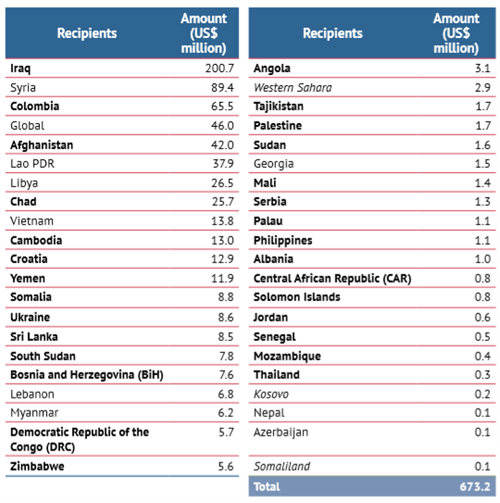
Note: States Parties to the Mine Ban Treaty are indicated in bold; other areas are indicated by italics.
In 2017, 29 states and areas experienced a change of more than 20% in funding compared to 2016, including 14 recipients receiving more support, and 15 recipients receiving less support, four of which received no support. These fluctuations may be a reflection of shifts in donor priorities and changes in local situations.
Iraq and Syria were the recipients with the largest increases, receiving respectively $120 million and $70.8 million more than in 2016, notably following the massive increases in the contributions of the US and Germany as previously detailed. In addition, three countries saw a substantial increase in support received: Colombia ($39.3 million more), Chad ($25.3 million more), and Libya ($18.6 million more).
- Support to Colombia ($65.5 million) more than doubled from 2016. In 2017, the Howard Buffett Foundation made a $16.1 million donation to support clearance activities in Colombia. Three donors considerably increased their contributions compared to 2016: the US ($12.5 million more), Japan ($7.8 million more), and Switzerland ($1.2 million more). These three countries participated in the Global Demining Initiative for Colombia ministerial-level meeting in September 2016, during which they pledged financial assistance to support Colombia’s mine action activities in the context of the peace process.[20]
- Support to Chad jumped from $0.4 million in 2016 to $25.7 million in 2017, following the awarding of EU funding to support capacity-building, clearance, risk education, and victim assistance activities. The EU was Chad’s sole international donor in 2017.
- Support to Libya ($26.5 million) more than tripled from 2016. This was due to the increase in the US contribution ($16 million provided in 2017 compared to $2.5 million in 2016) in order to build the operational capacity to dispose of improvised explosive devices (IEDs) and to support clearance operations in Sirte, as well as to contribute to the development of the Libya Mine Action Center. Libya also received significant contributions from the EU and Germany, both providing more than $3.5 million each.
Croatia was the recipient with the largest decrease, receiving $37.8 million less than in 2016. Three additional countries experienced a high-value decline in support received in 2017: Cambodia ($20.2 million less), Afghanistan ($15.3 million less), and Lebanon ($10.1 million less). These decreases were the result of changes in donors’ contributions:
- Support to Croatia in 2017 ($12.9 million) was one quarter of that in 2016, primarily due to a decline after massive EU contributions to support clearance activities with $50.7 million provided in 2016.
- Support to Cambodia ($13.0 million) was reduced by more than half in 2017. The drop was mainly due to lower contributions from Australia (a decrease of $3.3 million less compared to 2016) and Japan (a decrease of $15.1 million).
- Support to Afghanistan dropped by a quarter in 2017. This was in large part a result of decreases in funding provided by the US ($11.6 million less than in 2016) and Canada ($2.9 million less). Despite these decreases, Afghanistan was the fourth largest recipient of mine action support.
- Support to Lebanon ($6.8 million) more than halved in 2017 and marked the return to a level of funding closer to that reported in 2014 ($7.0 million) and 2015 ($8.7 million).
Summary of changes in 2017
|
Change |
Recipients |
Combined Total |
|
Increase of more than $10 million |
Chad, Colombia, Iraq, Libya, and Syria |
$273.9 million increase |
|
Increase between $10 and $1 million |
Georgia, Lao PDR, Sri Lanka, South Sudan, Vietnam, and Yemen |
$18.4 million increase |
|
Increase of less than $1 million |
BiH, CAR, Jordan, Palau, the Philippines, Senegal, Serbia, the Solomon Islands, Western Sahara, and Zimbabwe |
$4.9 increase |
|
Decrease of more than $10 million |
Afghanistan, Cambodia, Croatia, “Global,” and Lebanon |
$94.4 million decrease |
|
Decrease between $10 and $1 million |
Angola, Palestine, Somalia, and Ukraine |
$8.1 million decrease |
|
Decrease of less than $1 million |
Albania, Azerbaijan, DRC, Kosovo, Mali, Mozambique, Myanmar, Somaliland, Sudan, Tajikistan, and Thailand |
$3.5 decrease |
|
Recipients from 2016 that did not receive new support in 2017 |
Benin, Marshall Islands, Nigeria, and Peru |
$1 million received in 2016 |
|
New recipients in 2017 |
Nepal |
$0.1 million received in 2017 |
Funding by Thematic Sector
In 2017, 59% of mine action funding supported clearance and risk education activities, while support to victim assistance represented 2% of the total international support to mine action.
“Various” funding represented 37% of all international support to mine action. This includes contributions not disaggregated by the donors, as well as funding not earmarked for any sectors.
Contributions by thematic sector in 2017[21]
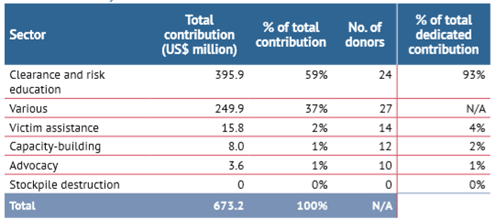
Notes: N/A = not applicable. “Dedicated contribution” (non-various funding) totaled $423.2 million in 2017 and included funding set for a specific sector (advocacy, capacity-building, clearance, risk education, stockpile destruction, or victim assistance). The “0” in stockpile destruction in 2017 does not mean states expended no funds for that activity, but rather that none of the contributions reported in 2017 detailed dedicated stockpile destruction funding.
Distribution of dedicated contributions by thematic sector
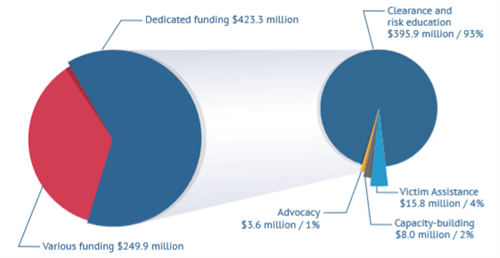
Clearance and risk education
In 2017, $395.9 million, or 59% of all reported support for mine action, went toward clearance and risk education activities. This represents an increase of $49.1 million from 2016.[22]
Five of the 10 largest donors—the US, Germany, Norway, the UK, and the EU—provided 80% of all support to clearance and risk education ($315.6 million).
Many donors reported clearance and risk education as a combined figure. Twenty-two donors did, however, indicate contributions specifically for clearance activities, providing a total of $187.8 million in 32 countries and other areas (21 States Parties, eight states not party, and three other areas).[23]
Twelve donors reported contributions totaling $7.2 million specifically for risk education projects in 13 countries.[24] Iraq received the most risk education-specific funding with $1.8 million.
Victim assistance
Direct international support for victim assistance activities remained below the level of most previous years, and decreased significantly as a percentage of total mine action funding. Based on information available as of October 2018, in 2017, $15.8 million was reported, down from $21 million in 2016. This represents just 2% of all reported support for mine action, in comparison, victim assistance funding ranged between 4% and 7% of all support from 2013 to 2016. This estimate may be conservative in that some donors were not able to provide specific details on dedicated victim assistance funding at the time of writing, but it still provides an informative picture of the global victim assistance funding situation.
Fourteen[25] donors reported contributing to victim assistance projects in 10 States Parties, and four states not party.[26] Most mine-affected countries did not receive any direct international support for victim assistance. Funding for victim assistance activities, however, is especially difficult to track because many donors report that they provide support for victims through more general programs for development and for the rights of persons with disabilities. Since such contributions are not disaggregated, it is not possible to include them in Monitor reporting.
The top three victim assistance donors—Germany, Switzerland, and Norway—provided 60% ($9.5 million) of all victim assistance funding in 2017.
Eight donors reported contributing $12.3 million, more than three-quarters (78%) of all support to victim assistance in 2017, through the ICRC or national Red Cross and Red Crescent societies.
Advocacy and capacity-building
In 2017, just 1% of all reported support for mine action went toward advocacy activities ($3.6 million).[27] Of the 37 donors reporting international contributions to mine action, 10 reported supporting advocacy activities.
Thirteen donors provided $8 million—1% of all international support—to support capacity-building activities in seven States Parties and two states not party.
National Contributions in 2017
While there has been more transparency from affected states, overall national contributions to mine action continue to be under-reported. Few States Parties report national funding in their annual Article 7 reports.[28] States Parties such as Iraq and Sri Lanka, as well as states not party India and Vietnam—all mine-affected states with significant contamination and major clearance operations, usually conducted by the army—have never reported annual expenditures.
Ten affected states reported $98.3 million in contributions to mine action from their national budget in 2017, $13.3 million more than the $85.0 million reported in 2016, but far from the $131.2 million reported in 2015.[29]
In 2017, one state completely funded its own mine action program: Chile.[30] Additionally, four States Parties reported funding more than half of their own mine action programs: Angola, BiH, Croatia, and Sudan.
National support: 2017
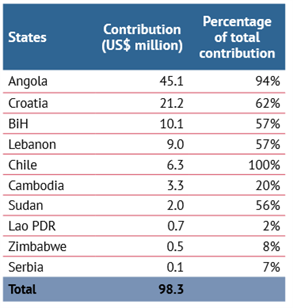
Five-Year Support to Mine Action 2013–2017
Over the past five years (2013–2017), total support to mine action amounted to some $3.1 billion, an average of about $623 million per year.
Although data about national support remains incomplete, such support has accounted for about one-quarter of total mine action funding over the period, and amounted to approximately $709.1 million.
International support totaled $2.4 billion, an average of $481 million per year, and represented 77% of all support. Three donors—the US ($847.4 million), the EU ($301.5 million), and Japan ($235.5 million)—contributed $1.4 billion, more than 50% of total international support. Four other donors—Germany, the Netherlands, Norway, and the UK—contributed more than $100 million each. Support from States Parties accounted for half of all international funding with $1.2 billion provided.
Between 2013–2017, the top five recipients—Iraq ($402.6 million), Afghanistan ($261.6 million), Lao PDR ($182.3 million), Cambodia ($132.5 million), and Colombia ($131.0 million)—received 46% of all international contributions. Syria was the only other country receiving more than $100 million over this five-year period.
Summary of contributions: 2013–2017
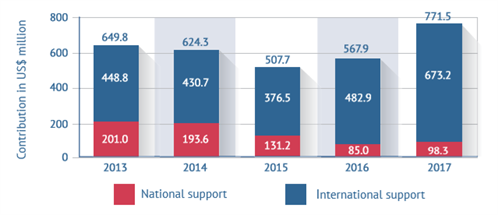
[1] This figure represents reported government contributions under bilateral and international programs for calendar year 2017, as of October 2018. All dollar values presented in this chapter are expressed in current dollars. Mine action support includes funding specifically related to landmines, cluster munitions, explosive remnants of war (ERW), and improvised explosive devices (IEDs) but is rarely disaggregated as such. State reporting on contributions is varied in the level of detail and some utilize a fiscal year rather than the calendar year. The total amounts of international support between 2012 and 2016 were updated to include revised contributions from the European Union (EU) and the United States (US).
[2] In 2012, international and national support totaled US$756.2 million. Adjusted for inflation, 2012 global support is $807.3 million in 2017 dollars, the highest annual total on record. The Monitor used the annual average of US All Urban Consumers Price Index (for all items) to adjust data on support for mine action for inflation. US Bureau of Labor Statistics, “Databases, Tables & Calculators by Subject: CPI-All Urban Consumers (Current Series),” Data extracted on 4 November 2018, https://data.bls.gov/timeseries/CUUR0000SA0.
[3] The Monitor maintains records of international support to mine action back to 1996, and national support back to 2002. The 2017 international support total is the highest in nominal and inflation-adjusted terms.
[4] Data for 2017 on international support to mine action is based on reviews of Mine Ban Treaty Article 7 Reports, Convention on Cluster Munitions Article 7 Reports, Convention on Conventional Weapons (CCW) Amended Protocol II Annual Reports, ITF Enhancing Human Security Annual Report 2017, UNMAS Annual Report 2017, and answers from donors to questionnaires. Thirteen of the 28 States Parties documented in this chapter reported international funding for mine action in a Mine Ban Treaty Article 7 Report for 2017, compared to 16 out of 25 States Parties in 2016.
[5] Amounts indicate the country in which funds were to be used. Funds often are not used by the governments in recipient countries, but instead by those providing services.
[6] In 2016, mine action donors reiterated their commitment to provide resources to support mine action efforts in the coming years through three pledging conferences in support of: the implementation of the Mine Ban Treaty (First Pledging Conference, Geneva, March 2016), Iraq (Washington, DC, July 2016), and Colombia (in New York City, September 2016). In 2016–2017, Canada, Germany, the Netherlands, New Zealand, the United Kingdom (UK), and the US announced significant increases in their funding to support mine action efforts. See, Monitor factsheet, “Extraordinary Pledges to Support Mine Action in 2016,” 22 November 2016, www.the-monitor.org/media/2388355/2016-Pledging-Conferences-fact-sheet_final.pdf; and Landmine and Cluster Munition Blog, “Pledges of New Funding in Support of Humanitarian Mine Action,” 13 April 2017, bit.ly/MBT2017Pledgeblog.
[7] Australia, Finland, Germany, Italy, Japan, the Netherlands, New Zealand, Norway, Poland, Switzerland, and Thailand. Mine Ban Treaty, Third Pledging Conference Report, 27 February 2018, bit.ly/MBT3rdPledging.
[8] UNDP, “Viet Nam: Mine Action Project launched with support from Korea,” Press release, 9 March 2018, bit.ly/MaVietnamKoreaMar2018.
[9] Statement of Australia, Mine Ban Treaty Intersessional Meetings, Session on International Cooperation and Assistance, Geneva, Switzerland, 8 June 2018, bit.ly/AustraliaISM2018. Exchange rate for June 2018: A$1=US$0.7498. US Federal Reserve, “Foreign Exchange Rates (monthly),” 4 September 2018, www.federalreserve.gov/releases/g5/current/default.htm.
[10] Department for International Development, “UK aid will protect more than 820,000 people from threat of lethal landmines,” Press release, 6 September 2018, www.gov.uk/government/news/uk-aid-will-protect-more-than-820000-people-from-threat-of-lethal-landmines. Exchange rate for 6 September 2018: £1=US$1.2933. US Federal Reserve, “List of Exchange Rates (Weekly),” 10 September 2018, www.federalreserve.gov/releases/h10/20180910/.
[11] South Korea and the US are the two states not party. The six institutions are Howard Buffett Foundation, the Organization for the Petroleum Exporting Countries (OPEC) Fund for International Development (OFID), the Sudan Humanitarian Fund, the United Nations Association (UNA)-Sweden, the UN, and the UN Office for the Coordination of Humanitarian Affairs (OCHA).
[12] Eighteen EU Member States provided funding in 2017: Austria, Belgium, Czech Republic, Denmark, Estonia, Finland, France, Germany, Ireland, Italy, Luxembourg, the Netherlands, Poland, Portugal, Slovenia, Spain, Sweden, and the UK.
[13] The amount for each donor has been rounded to the nearest hundred thousand. The total amount of international support for 2013, 2014, 2015, and 2016 were updated as a result of revised EU and US funding totals.
[14] Finland budgeted funding for mine action in 2016, but it was reported that payments could not be executed due to changes in the administration and the extension of the tender-processes. As a result, no support was reported in 2016, and the 2017 total included some of the funding initially budgeted for 2016.
[15] Average exchange rates for 2017: A$1=US$0.7671; C$1.2984=US$1; DKK6.5957=US$1; €1=US$1.1301; ¥112.1=US$1; NZ$0.7111=US$1; NOK8.2679=US$1; SEK8.5430=US$1; CHF0.9842=US$1; and £1=US$1.2890. US Federal Reserve, “List of Exchange Rates (Annual),” 11 January 2018, www.federalreserve.gov/releases/G5a/current/default.htm.
[16] The small donors included Andorra, the Czech Republic, Estonia, Liechtenstein, Poland, and Portugal, as well as OCHA, the Sudan Humanitarian Fund, and UNA-Sweden.
[17] Only Afghanistan had the same number of donors in 2017.
[18] Recipients with one donor included: Albania, Azerbaijan, Central African Republic (CAR), Chad, Mozambique, Nepal, the Philippines, Senegal, Serbia, Solomon Islands, Thailand, and other area Somaliland.
[19] Recipients of international support with massive contamination included: Afghanistan, Angola, Azerbaijan, BiH, Cambodia, Chad, Croatia, Iraq, Thailand, Yemen, and the other area Western Sahara. Recipients with heavy contamination included: Colombia, Lebanon, Somalia, South Sudan, Sri Lanka, and Zimbabwe.
[20] At the Global Demining Initiative for Colombia ministerial-level meeting, the US pledged $36 million over 2016–2018, and Switzerland pledged $4.1 million over 2016–2020. Japan pledged $1.5 million without specifying the timeframe, but this seems to correspond to the amount provided in 2016. See, Monitor factsheet, “Extraordinary Pledges to Support Mine Action in 2016,” 22 November 2016, www.the-monitor.org/media/2388355/2016-Pledging-Conferences-fact-sheet_final.pdf.
[21] In 2016, international support was distributed among the following sectors: clearance and risk education ($346.8 million, or 72% of total international support), victim assistance ($21.0 million, or 4%), capacity-building ($12.5 million, or 3%), advocacy ($2.5 million, or 1%), stockpile destruction ($0 million, or 0%), and various activities ($100.1 million, or 20%). Data for 2016 was revised—based on new figures that detailed dedicated clearance and risk education funding as well as contributions that were not previously reported by donors.
[22] Albania, Chad, Nepal, Serbia, and Sudan were the five recipients which did not receive funding dedicated to clearance and risk education in 2017. This does not mean that donors did not support activities related to this sector, but that none of the contributions reported detailed specific funding going to clearance and risk education only.
[23] States Parties recipients of international assistance for clearance were: Afghanistan, Angola, BiH, Cambodia, Colombia, Croatia, DRC, Iraq, Mali, Mozambique, Palau, Palestine, the Solomon Islands, Somalia, South Sudan, Sri Lanka, Tajikistan, Thailand, Ukraine, Yemen, and Zimbabwe. States not party that received international assistance for clearance were: Azerbaijan, Georgia, Lao PDR, Lebanon, Libya, Myanmar, Syria, and Vietnam. Other areas that received international assistance for clearance activities were: Kosovo, Somaliland, and Western Sahara.
[24] Recipients of international assistance for risk education were: Cambodia, CAR, Colombia, DRC, Iraq, Jordan, Lao PDR, Libya, Mali, Myanmar, Syria, Ukraine, and Yemen.
[25] Victim assistance donors included: Australia, Austria, Canada, Germany, Italy, Japan, Liechtenstein, New Zealand, Norway, Slovenia, Switzerland, Turkey, the EU, and the OFID.
[26] States Parties recipients of international assistance for victim assistance were: Afghanistan, BiH, Cambodia, Colombia, DRC, Iraq, Palestine, Somalia, South Sudan, and Ukraine. States not party that received international assistance for victim assistance were: Lao PDR, Lebanon, Myanmar, and Nepal.
[27] Advocacy activities generally include, but are not limited to, contributions to the Convention on Cluster Munitions and the Mine Ban Treaty Implementation Support Units, the Gender Mine Action Programme (GMAP), the Geneva Center for Humanitarian Demining (GICHD), Geneva Call, and the ICBL-CMC and its Landmine and Cluster Munition Monitor.
[28] Two of the 10 affected states analyzed in this chapter reported national funding for mine action in a Mine Ban Treaty Article 7 report for 2017: Cambodia and Zimbabwe. Four others provided details on their national contribution for mine action in their extension requests: BiH, Croatia, Serbia, and Sudan. Lao PDR and Lebanon reported their national contributions in their Convention on Cluster Munitions Article 7 reports for 2017. Information on national mine action provided in 2017 by Angola and Chile is available in their respective annual national budget laws.
[29] Eleven affected states reported on their national contributions in 2016: Angola, BiH, Chad, Chile, Croatia, Ecuador, Lao PDR, Lebanon, Mauritania, Sudan, and Zimbabwe.
[30] Chile has not received international support since 2007.

